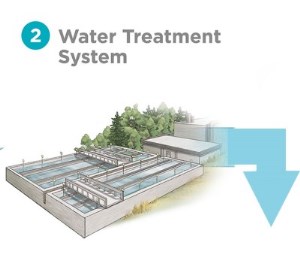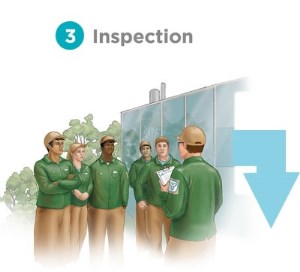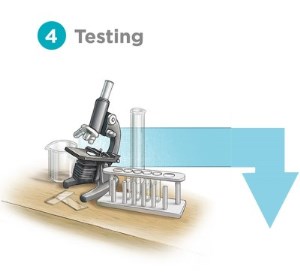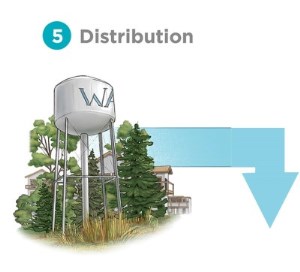Know Your Signs

Sure we all know what the different speed signs mean, but have you ever seen a Drinking Water Source Protection sign and wondered what it actually meant? Maybe you've driven by them and not even noticed them.
We're here to tell you Drinking Water Source Protection couldn't be MORE important. And when you see one of these signs when travelling across our region or across Ontario, it is definitely worth paying attention to.
Source Water Protection is about keeping Ontarians and their families safe, and when it comes to helping our families, our friends, our neighbours, and our communities, we ALL have a role to play. Drinking Water Source Protection is everyone's responsibility.
Our municipal drinking water is already safe and reliable. It goes through a rigorous treatment process with numerous measures in place to ensure its safety. But what about the water that comes into the treatment plant? This “source” of municipal water needs to be protected as well. That’s what the Source Water Protection Program is all about. It’s about safeguarding the water that comes into those treatment plants. That’s the water we get from underground supplies called aquifers, and surface water in lakes and rivers.
| Drinking Water Threats |
|
The legislation (Clean Water Act) says that municipal drinking water sources must be protected against 22 threats, which can be roughly categorized as:
|
| How Does This Impact Me? |
|
Source Water Protection primarily impacts people who live or own property or a business in vulnerable areas near municipal sources of drinking water. If you own property in a vulnerable area and are applying to the municipality for an activity under the Planning Act (Minor Variance, Zoning By-law Amendment, Consent/Severance, etc.) or the Building Code Act (e.g. Building Permit), you should visit our Source Protection Notice page for information on how to get permission from the Risk Management Official for these applications. People who live or work in a vulnerable area have a special responsibility to be aware of their actions and how they can negatively impact our drinking water supplies – a responsibility we hope they take seriously. |
| Am I in a Vulnerable Area? |
|
You can find out if you live or own property in a vulnerable area by contacting your local Risk Management Official (RMO), or by checking Provincial mapping or our property mapping. Risk Management Officials are often municipal staff members with specialized training and qualifications who work with landowners to ensure their activities do not pose a threat to our drinking water supplies. Risk Management Officials may also work for your local Source Protection Authority. All of them possess documents that certify their status and training. You can ask to see their credentials anytime. If you are in a vulnerable area and you plan on making changes to your property’s use, you may be required to speak with a Risk Management Official. Certain activities may be prohibited or restricted or subject to a Risk Management Plan. This is a legally-binding agreement between a landowner, tenant or business and a Risk Management Official. The plan documents what measures are already in place and what needs to be added so that activities on the land are no longer a risk to the water supply. |
Source Water Protection is based on science
When the Source Water Protection Program began in 2007, a lot of research and technical studies went into mapping out the areas around municipal wells and surface water intakes. Maps for every well and intake have been created that show the vulnerable areas that we need to pay special attention to as contamination and overuse in those areas can have negative impacts.
Wellhead Protection Areas
Wellhead Protection Areas (WHPAs) are areas around municipal wells where the groundwater is travelling toward that well when the well is being pumped. These areas need to be protected from certain activities to ensure they don’t pose a risk to the well. In general, the closer you are to a wellhead, the greater the threat of contamination.
Intake Protection Zones
Intake Protection Zones (IPZs) are areas around the end of the surface water intakes that bring water from lakes and rivers into treatment plants. Keeping contaminants away from intakes means that the water travelling to the municipal treatment plant is the highest quality possible before it is treated and gets to your tap.
Managing Source Water Protection threats in colder weather
The goal of source protection is to manage or eliminate existing activities that are, or could be, significant threats to a water supply.
The Clean Water Act, 2006 lists 20 human activities that are a threat to water quality and 2 that are threats to water quantity.
What are significant threats?
There are many potential threats to drinking water, but the level of risk they pose depends on the nature of the activity and its location.
The threats that pose the greatest risk to a drinking water supply are called "significant threats."
A significant threat:
- is located in the more vulnerable areas near a well or intake.
- has a high hazard rating based on the nature of the material, how it is stored, how it is used, etc.
| Source Protection information for Real Estate |
|
This primer was developed to help you understand the impact of drinking water source protection − so you can provide your clients (whether you represent a buyer or a seller) with relevant information about the property for sale. What is a vulnerable area?Drinking water source protection is based on science. Local scientific data was used to create maps that show vulnerable areas – which can be located on residential, agricultural, commercial or industrial, rural or urban, developed or undeveloped lands. The land around municipal wells and intakes is especially sensitive because it contributes to a municipal drinking water supply source. In these areas, we need to pay attention to activities causing contamination and overuse of our drinking water sources. What might this mean for my client?If any part of the property is located in a vulnerable area, then certain activities may be restricted on the property, or in rare cases prohibited. Your potential buyer needs to be aware of their responsibilities under the Clean Water Act, and local source protection plan policies. If a property is changing hands and/or uses, then policies may require that a risk management plan be put in place. The local risk management official or inspector will work with the landowner (or renter) to develop a risk management plan that contains measures to protect sources of drinking water. Here are some of the more common examples of activities that could pose a risk to drinking water: Residential Properties
Commercial/Industrial Properties
Agricultural Properties
Building in a vulnerable areaMake sure your client checks with the municipality about any new use, business or construction proposed for the property. Development applications and planning or building permits What if I sell and list properties in more than one area?Policies can differ from one source protection region or area to another, as each has a local source protection plan in place to address local needs. You’ll find that each region/area in Ontario has a website listing local plan information and maps. Does the property have a septic system?The Ontario Building Code requires that septic systems in certain vulnerable areas surrounding municipal drinking water sources be inspected every five years. It’s important for the landowner to keep the septic tank and tile field in good working order and understand what should not be put into it, to minimize risk of health and environmental problems that can impact water sources.
|
Source Protection information for the Agricultural community |
|
Several agricultural activities are listed as drinking water threats under Ontario’s Clean Water Act, 2006. Given the rural nature of the Kawartha-Haliburton Source Protection Area, agricultural activities are widespread throughout. The actual number of these activities that occur within the vulnerable areas of municipal drinking water systems is relatively small. Agricultural activities are considered to be potential threats to drinking water due to the possibility for release of chemicals (such as nitrogen, phosphorus and pesticides) and bacteria into ground and surface water. Which agricultural activities are considered threats?Specific agricultural activities that are listed in the regulations under the Clean Water Act, 2006 as significant drinking water threats are:
The occurrence of these activities in vulnerable areas does not necessarily mean they are significant drinking water threats. That determination is made based on site specific circumstances such as the nature of the agricultural operations and facilities. In order to protect drinking water sources, farmers should
|
Source Protection information for Fuel Oil Sources and Storage |
How do you store and handle your fuel?Even a small fuel spill can lead to big problems for our water. In fact, Statistics Canada reports that one litre of gasoline can contaminate up to one million litres of water. This can happen when fuel (such as that used for home heating, to run vehicles, or for manufacturing) is improperly used or stored. Fuel that’s been spilled or that leaks can quickly travel into ground or surface water. From there, the fuel can spread over a large distance, which makes clean up difficult and costly. What's the risk?Fuels contain chemicals that are hazardous to our health. Home heating oil, for example, contains BTEX which stands for benzene, toluene, ethyl benzene and xylene. These hazardous chemicals are linked to serious health concerns, including certain cancers and birth defects. If fuel gets into our drinking water, it brings BTEX with it, putting us all at risk. Fuel tank safety tips
Caring for your fuel tankProper care of your fuel tank is in everyone’s best interest. Not only can there be a significant environmental impact, but clean up can be costly and is not always covered by your insurance. So it’s important that anyone with a fuel tank – whether for home or commercial use – know the warning signs of a leak. Contact your oil/gas supplier or an oil burner technician if you see or experience any of the following issues:
Managing the riskAnyone with a property near a municipal well or surface water intake needs to pay special attention when it comes to protecting our sources of drinking water. In vulnerable areas, you may need to get regulatory approval if you handle or store more than 250 litres of fuel. This depends on the location of your tank, and whether it’s above grade, partially below grade, or below grade. Your local Risk Management Official (RMO) will work with you to determine if your activity poses a threat to drinking water, and if so, how you might manage the risk. |
Source Protection information for Snow Storage |
|
The storage of snow is considered a drinking water threat under Ontario’s Clean Water Act, 2006. Snow ploughed from roads and parking lots can be contaminated with road salt, oil, grease and heavy metals from vehicles, litter, and airborne pollutants. When the snow melts, these contaminants are released and can enter nearby surface water and groundwater creating a threat to drinking water sources. Snow, therefore, must be stored and disposed of in an appropriate manner. Storing large quantities of snow in one location concentrates the contaminants in melt water, which results in a greater impact on the surrounding environment. If the storage area is large, a significant release of chemicals to groundwater or surface water can occur. These include sodium and chloride from road salt. Snow storage is considered to be a significant drinking water threat in many vulnerable areas surrounding municipal wells (WHPAs) and intakes (IPZs). |
Source Protection information for Road Salt, Storage and Application |
|
We all want clean, safe water for our future. Protecting our drinking water sources is the first step. Our drinking water comes from water under the ground, called groundwater, or from water in lakes and rivers, called surface water. In our climate road salt is used to keep our roads, walkways and parking lots, safe and passable. Even though it helps to keep us safe, road salt can get into our drinking water sources and contaminate them. Not only can surface water and groundwater be impacted by road salt, but also vegetation, aquatic life, wildlife, and soils. Cars, concrete, clothing and footwear can be damaged too. What can you do?
|
Multi-Barrier Approach
In the Walkerton Inquiry Report, Justice O'Connor called for a multiple-barrier water management approach to prevent a similar tragedy from occurring again. Drinking water is best protected by taking an approach that uses multiple barriers to prevent contamination from affecting our drinking water. Known as the 'multi-barrier approach', it includes taking actions to prevent contamination of sources of our water, using adequate water treatment and distribution systems, water testing and training of water managers.
| Ontario's Multi-Barrier Approach |
Ontario’s drinking water protection framework was developed as a result of the Walkerton inquiry and the subsequent recommendations by Justice O’Connor in 2002. Since that time, numerous steps have been taken to protect drinking water, including:
|
Source Water Protection
Our sources of drinking water are lakes, rivers and groundwater aquifers. By protecting these sources from contamination and depletion, we can enjoy clean and abundant water for future generations. Ontario’s Clean Water Act helps protect sources for our municipal drinking water systems.
| Read more |
|
Source water refers to untreated surface water from lakes and rivers and groundwater aquifers from which we get the water to supply drinking water systems. All of these sources of water are linked in a watershed through the water cycle. Drinking water sources can be easily contaminated from a variety of activities performed on the landscape. Long-term problems can develop that are costly or even impossible to correct. Source water protection is about protecting these water sources from both contamination and depletion, ensuring a long-term supply of clean water for future generations. Today, Ontario has a comprehensive drinking water protection framework from source to tap. After the tragic events of 2000 in Walkerton, Ontario a public inquiry was held. Justice O’Connor made 121 recommendations on a wide range of areas related to protecting drinking water. These recommendations became the building blocks of Ontario’s drinking water protection framework. One of Justice O’Connor’s recommendation was that drinking water should be protected by developing watershed-based source protection plans. As a result, the Clean Water Act was created in 2006 to ensure municipalities protect their existing and future drinking water supplies through prevention. Through the creation and implementation of collaborative, watershed-based source protection plans that are locally driven and based on science, sources of municipal residential drinking water are now protected. Certain other types of drinking water systems can also be brought under the source protection planning process, as specified in the Clean Water Act. There are 19 multi-stakeholder source protection committees across Ontario representing business, public, municipal and indigenous interests. These committees have developed 38 local source protection plans that identify a variety of actions to protect sources of municipal residential drinking water systems. |
Water Treatment System
The source water from our lakes, rivers and groundwater must be treated so that any harmful contaminants and organisms are reduced or removed. In Ontario, municipalities use different water sources and provide the treatment needed, so that you and I can #TrustTheTap for safe, clean drinking water.
| Read more |
|
Treatment processes reduce or eliminate the potential for the presence of chemicals and pathogens in drinking water and are used to ensure your drinking water meets provincial standards. Different water sources necessitate different levels and methods of treatment to ensure safe, clean water is provided to consumers. All municipal drinking water systems in Ontario must have a disinfection process in place and all water must be disinfected before it is supplied to the public. The most widely used disinfectant is chlorine, which is a low-cost powerful disinfectant which continues disinfecting as water passes through the distribution system. In order to comply with the provisions of Ontario Regulation 170/03, Drinking-Water Systems, (a regulation under the Safe Drinking Water Act, 2002) all municipal drinking water systems in Ontario must:
These requirements ensure an adequate level of removal or inactivation of pathogenic organisms that may be present in the raw water, prevent re-contamination of drinking water within the distribution system, and, maintains drinking water quality throughout the distribution system. Skilled and competent drinking water system operators are crucial to maintaining safe water quality. They operate disinfection and treatment equipment, respond to equipment alarms and test and treat drinking water to help ensure that it is safe to drink. Ontario Regulation 128/04, Certification of Drinking Water System Operators and Water Quality Analysts (another regulation under the Safe Drinking Water Act, 2002) ensures that drinking water systems maintain fully qualified and trained staff. The regulation provides the framework for the certification of drinking water operators, and the Ministry of the Environment Operator Certification Program. Once certified, operators are required to renew their certificates every three years. |
Inspection
The government of Ontario carries out inspections of municipal residential drinking water systems per the Safe Drinking Water Act. An inspection rating is given to each system to show how well it follows the rules. If a problem is found, the inspector can prescribe timely corrective actions.
| Read more |
|
There is a Compliance and Enforcement regulation of the Safe Drinking Water Act. This regulation sets out responsibilities of the provincial government to be legally accountable for its oversight role in protecting drinking water. These responsibilities include:
In Ontario, all municipal residential drinking water systems are inspected at least once a year. During an inspection, the inspector evaluates requirements such as the operation of the treatment system, policy Each system is assigned an inspection rating that reflects how well the system complied with requirements. Of the 659 inspections conducted in 2018-19, 656 or 99.5% received an inspection rating greater than 80%, with 477 or 72% scoring 100%. In cases where the inspection identifies a problem, the inspector can work with the system owner to bring the system into compliance or issue an order that prescribes corrective actions within a certain timeframe. |
Testing
Trained and certified operators regularly test our municipal residential drinking water. This is a good way to check the quality of drinking water and also the system’s ongoing ability to provide safe drinking water. If a test shows any problems with the water quality, corrective actions are applied.
| Read more |
|
Ontario’s drinking water is carefully monitored through regular testing by certified operators who take thousands of drinking water samples every year which are tested at provincially licensed and eligible laboratories for microbiological organisms and chemical substances. Drinking water quality test results are a good way to demonstrate the quality of drinking water and provide ongoing evidence of a system’s ability to provide safe drinking water. In Ontario, when systems have test results that do not meet standards, this often relates to microbiological and chemical exceedances. Corrective actions can include adjustments to treatment equipment or other operational activities. Successful implementation of these actions is often confirmed by resampling. In 2018-19, 99.87% or 522,231 of the 522,921 drinking water test results from 661 municipal residential drinking water systems met the standards. |
Distribution
The distribution system includes pipes, pumping stations, and more, to carry the treated drinking water to our property lines. Municipalities make sure that there is disinfectant in this system too, and test it regularly to check that clean, safe water is conveyed.
| Read more |
|
A water distribution system is the network of pipes, valves, fire hydrants, storage tanks, reservoirs and pumping stations that carry water to customers. If a distribution system is poorly maintained, then clean, treated drinking water can easily become contaminated. Municipal drinking water system owners are required to maintain a consistent level of disinfectant throughout the distribution system and in plumbing connected to the distribution system, to act as a barrier against contamination. This helps to protect water from microbiological re-contamination, reduce bacterial regrowth, control biofilm formation, and serves as an indicator of the integrity of the distribution system. Testing is also conducted within the distribution system to check the conveyance of safe drinking water. |
Drinking Water
More than 80% of Ontario’s population receives their drinking water from a municipal drinking water system! Pandemic or not, safe and abundant drinking water is one of the key pillars of public health. Protection of our drinking water is a shared responsibility, which is achieved through a multi-barrier approach.
| Read more |
|
Safe and abundant drinking water is one of the key pillars of public health in Ontario. Ensuring that Ontarians, regardless of socioeconomic status or geographic location, have access to safe drinking water is essential to the health of our population. Protection of our drinking water is a vital responsibility shared by many partners. More than 80% of Ontario’s population receives their drinking water from a municipal drinking water system. Municipalities own or have water supplied to them through, various types of drinking water systems. In his inquiry report of the Walkerton tragedy, Justice O’Connor also recommended the adoption of quality management for municipal drinking water systems. As a result, the comprehensive Drinking Water Quality Management Standard (DWQMS) is mandated under the Safe Drinking Water Act, and provides a proactive and preventative approach to management strategies that identify and manage risks to public health. It supports the establishment and documentation of management procedures, clearly identifying roles and responsibilities; and allows for a continual improvement process. These form part of the multi-barrier approach in Ontario. There are two main types of non-municipal drinking water systems: non-municipal year-round drinking water systems and designated facilities. For more information about these systems, please visit: https://www.ontario.ca/page/rules-non-municipal-drinking-water-systems There are also laws around private wells on properties, including how to maintain a well, and how to properly close it. Read more at: https://www.ontario.ca/page/wells-your-property The watershed-based approach recommended by Justice O’Conner begins with protecting our precious sources of drinking water. This is a shared responsibility, and all of our actions matter. |
Successes of Multi-Barrier Approach
- Since water quality test reporting began in 2004, more than 99.9% of the over 522,000 municipal drinking water system water quality tests continue to meet Ontario’s water quality standards.
- Ontario’s actions received an "A" ranking — the highest in Canada — in Ecojustice's Canada’s Drinking Water Report Card.
- There are 19 multi-stakeholder source protection committees across the province representing business, public, municipal and indigenous interests. These committees have developed 38 local source protection plans that identify actions to protect sources of municipal residential drinking water systems.
- The 38 source protection plans contain more than 12,500 policies to protect sources of municipal drinking water in Ontario for:
- Over 900 groundwater wells
- Over 70 Great Lakes intakes
- Over 60 inland lake intakes
- 13 Lake St. Clair and St. Lawrence River intakes.
- There are 22 prescribed drinking water threats being managed / removed from the landscape through source water protection.
- Over 1000 risk management plans have been established to manage drinking water threats on the landscape.
- 99.5% of 659 municipal residential drinking water systems received an inspection rating indicating over 80% compliance with Ontario’s regulations. 72% of systems received a perfect 100% rating.
- Over 5000 septic systems have been inspected for deficiencies
- As of March 31, 2019, there were 7,272 certified drinking water operators in Ontario who held a total of 10,040 certificates. This works out to a 22% increase over the last 10 years.
- Over 900 road signs have been installed on highways and major roads to identify the vulnerable areas around municipal drinking water systems.
Page developed in collaboration with the Quinte Conservation, Trent Conservation Coalition and Conservation Ontario.












